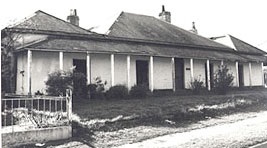Addington House

Located at: 813 Victoria Road, Ryde
Addington stands on part of the original grant made to James Stewart in 1794, where he erected a small three-bedroom cottage of sandstone. James Shepherd, who had been transported as a convict in 1791, purchased the farm in 1809. Shepherd's wife Ann Thorn, who he married in 1795, had also been granted 20 acres at Eastern Farms (vicinity of the modern day Meadowbank) and in 1799, Shepherd had begun to purchase farms adjoining Thorn Farm.
Shepherd and his sons erected a number of houses on their properties, including The Retreat adjoining Addington, for his daughter Ann Henry. Addington was occupied by Shepherd's son Isaac and western wing of two bedrooms and a verandah was added to the original structure in about 1832. Isaac Shepherd became a wealthy pastoralist and was member of the NSW Legislative Assembly in the 1860s. In 1850, the eastern wing comprising three rooms was added.
In 1861, Isaac Shepherd's daughter, Mary Elizabeth, married Thomas Bowden, the Colony's second schoolmaster, and they resided at Addington. They added a further three rooms and attics in front of the original structure There was, by this time, also an extensive range of outbuildings within Addington's curtilage.
In 1873, the Bowdens added a ballroom and following the house's redecoration together with this addition it reached its most complete form. After the death of Thomas Bowden in 1879, Addington was occupied by numerous tenants and also changed hands a number of times.
 The Benson family undertook extensive renovations in about 1920, when the floors and ceilings were renewed, drawing room reinstated and ballroom demolished. The house was not redecorated or added to again and had fallen into a state of disrepair until the Addington Trust was form in the 1970s and some essential works were carried out.
The Benson family undertook extensive renovations in about 1920, when the floors and ceilings were renewed, drawing room reinstated and ballroom demolished. The house was not redecorated or added to again and had fallen into a state of disrepair until the Addington Trust was form in the 1970s and some essential works were carried out.
The National Trust dates the central section to 1810, the west wing to 1822, and the east wing to 1840.
Addington is a single storey house in a colonial vernacular style built of sandstone with a brick wing at the rear. The facade facing Victoria Road is symmetrical with three hipped slate roof forms with portions of iron tiles. There is also a two room attic with rear facing dormer windows, in the central portion. A straight pitched verandah to the east and south is supported on simple rectangular timber posts.
A central front door and four pairs of shuttered French doors open onto a stone flagged verandah. Most external joinery and door furniture, including a six-panel front door and fanlight, are intact although not being the original fittings. There is a stone outbuilding at the rear with remnants of former structures, such as a kitchen, ballroom and greenhouse easily visible.
Internally the spaces are intact and provide evidence of the staged growth of Addington and the different construction details and techniques employed.
The City of Ryde, through an extensive restoration project that was undertaken in 1988, following its purchase in 1985, conserved Addington for the community.
As part of an extension to Addington's curtilage and to provide for car parking, the adjoining property at 815 Victoria Road, Ryde, was purchased and the contemporary residential structure demolished. Acquisition of this property, also created good separation between Addington and the adjoining heritage property, The Retreat at 817 Victoria Road, Ryde.
Addington is reported to be the oldest complete settlers cottage in Australia, is the oldest surviving building in Ryde and has many heritage listings:
- Register of the National Estate (002936)
- National Trust (ID 6568)
- State NSW Heritage Register (No. 33)
- City of Ryde's Heritage LEP 105
Current Condition
Addington is in fair condition requiring a progressive program of works over the short and medium term to bring the structure back to its restored state. The building was initially the subject of an extensive restoration in the 1980s.
Works required to bring the building back to a good standard include internal tasks such as general painting and inspection together with external works such as roof repairs, brick fretting, eradication of dampness and drainage issues and replacement of several building members. Works required within the building's curtilage include resetting of levels to divert water flow together with general maintenance.
Completion of these tasks will bring the building back to a state where the institution of a conservative works program will maintain its longevity.